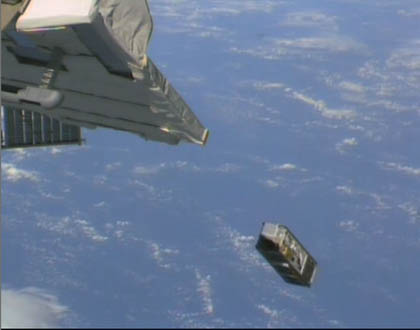Japanese and Brazilian CubeSats deployed from Kibo
Last Updated: October 22, 2015
On September 17, 2015, two CubeSats — SERPENS developed by the University of Brasilia (UnB) and S-CUBE of the Chiba Institute of Technology — were successfully deployed from the Japanese Experiment Module (“Kibo”).
First, at 9:02, p.m., S-CUBE was deployed via command operation by Astronaut Kimiya Yui aboard the International Space Station (ISS). Then at 9:12 p.m., SERPENS was deployed under command of the JAXA Flight Control Team (JFCT) at the Tsukuba Space Center (TKSC).
This series of deployment marks the fourth (12th satellite) deployment using the JEM Small Satellite Orbital Deployer (J-SSOD), and 90 satellites in total have been deployed from Kibo.

At the TKSC, representatives of the Chiba Institute of Technology and JAXA applauding the successful deployment (Credit: JAXA)

At the TKSC, representatives of the University of Brasilia and JAXA applauding the successful deployment (Credit: JAXA)
Developed by JAXA for deploying satellites designed in compliance with the CubeSat design specification (10 cubic cm), J-SSOD is a mechanism that transfers satellites from Kibo’s airlock to the space environment and then releases them into orbit.
SERPENS and S-CUBE are both 3U-sized micro satellites (10 cm×10 cm×30 cm)and were delivered aboard the H-II Transfer Vehicle (HTV) KOUNOTORI5.
There are now more opportunities for CubeSat deployment from Kibo. And various projects are ongoing, such as AOBA-VELOX-Ⅲ (of Singapore and Kyushu Institute of Technology) and a 50-kg-level CubeSat PHL-MICROSAT (jointly developed by the Philippines, Tohoku University, and Hokkaido University).
Since September 8, 2015, JAXA has collaborated with the UNITED NATIONS Office for Outer Space Affairs (UNOOSA) in order to provide opportunities for CubeSat deployment. In particular, JAXA and UNOOSA will strive to offer opportunities for CubeSat deployment from Kibo to developing nations, so as to contribute to their advancement of space and related technologies.
断りの無い限り、日時は日本時間です。
*All times are Japan Standard Time (JST)
This entry passed through the Full-Text RSS service – if this is your content and you’re reading it on someone else’s site, please read the FAQ at fivefilters.org/content-only/faq.php#publishers.



Comments are closed.